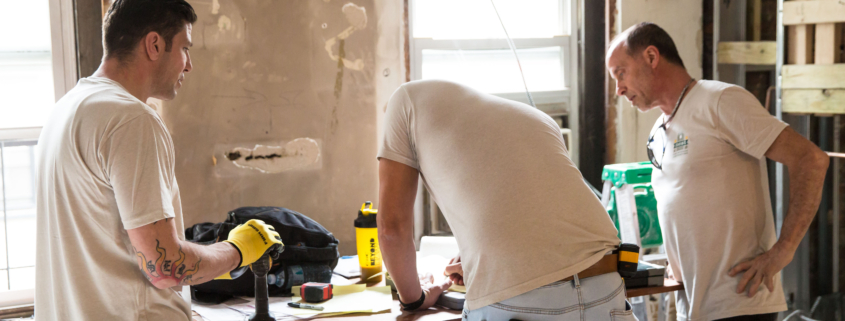How to Preserve Walls with Vintage Wallpaper Installation
There’s something undeniably special about vintage wallpaper. Whether it’s a bold 1960s geometric, a dainty Victorian floral, or a classic Art Deco pattern, vintage wallpaper installation offers an instant sense of charm, history, and depth that paint simply can’t match. But installing vintage wallpaper, especially authentic or reproduction papers, is not as simple as slapping it on and calling it done.
Done right, it’s not just a design statement; it’s a method of preserving walls with wallpaper. With the help of a skilled interior contractor, this process can breathe new life into a space while also protecting your underlying surfaces from wear, damage, or environmental exposure.
In this post, we’ll walk you through how vintage wallpaper helps preserve walls, what makes installation different from modern paper, and why expert handling is key to getting it right.
The Appeal of Vintage Wallpaper
Vintage wallpaper makes a room feel layered and lived in. It’s a design tool that tells a story, whether you’re restoring a historic brownstone in Brooklyn or adding personality to a modern loft. Unlike newer mass-market options, vintage wallpaper features distinctive printing techniques, like screen printing, flocking, metallic foils, and hand-painted details, that create rich visual texture.
Even when using high-quality reproduction wallpaper, you’re working with patterns and color palettes that reflect a different design era, instantly transporting the feel of the space.
But vintage paper does more than just elevate a room—it also offers a practical benefit: it acts as a barrier that helps preserve the underlying surface.
How Vintage Wallpaper Helps Preserve Walls
Most people don’t think of wallpaper as a wall-protecting material, but it can add a layer of defense to your walls, especially when properly installed with the right base layer and materials.
Here’s how:
It Protects Against Scuffs and Dings
Paper adds a physical barrier that guards drywall and plaster against small bumps and abrasions. In high-traffic areas like hallways or stairwells, wallpaper can prevent cosmetic damage that paint alone can’t withstand.
It Shields From Moisture and UV Light
Some vintage papers (particularly those with vinyl or coated finishes) help reduce damage from sunlight and humidity. When applied in a climate-controlled environment, wallpaper can help slow wall deterioration in older buildings.
It Helps Hide Imperfections
Walls in older homes often have minor cracks, dents, or uneven patches. Rather than resurfacing entirely, vintage wallpaper installation can camouflage these imperfections beautifully, especially when working with richly patterned or textured papers.
It Creates a Reversible Design Option
When you install vintage wallpaper using a liner paper or non-permanent adhesive, it becomes easier to remove later without damaging the wall underneath. This approach is especially useful in historical properties where wall preservation is a top priority.
What Makes Vintage Wallpaper Installation Unique?
Installing vintage or reproduction wallpaper isn’t quite like hanging a modern peel-and-stick mural. It requires patience, precision, and a deep understanding of materials. Here’s what sets it apart:
Delicate Materials
True vintage wallpaper may be fragile or brittle. Even high-end reproductions can be made with unique inks and papers that require gentle handling. Humidity, paste strength, and smooth brushing techniques all play a role in keeping the material intact during application.
Pattern Matching
Vintage patterns often have larger, more intricate repeats than contemporary designs. Matching these patterns at seams, especially in corners or around windows, takes a trained eye and steady hand. Misalignments can break the illusion and ruin the impact.
Surface Preparation
A flawless finish starts with the wall itself. Surface cleaning, patching, sanding, and sometimes applying a liner or primer coat ensure that the paper adheres properly and can be removed cleanly later if desired. This prep work is a critical part of preserving walls with wallpaper.
Specialized Adhesives
Depending on the age and type of paper, different adhesives are used—from traditional wheat paste to modern clear pastes. A professional interior contractor will select the correct type and viscosity to suit the paper’s thickness, backing, and condition.
Tips for Preserving Walls with Wallpaper
Whether you’re hiring a pro or tackling it yourself, there are a few key strategies to ensure your vintage wallpaper looks great and your walls stay safe.
Use Liner Paper
Installing a layer of liner paper (also called lining paper) underneath the wallpaper can create a smoother base and make the paper easier to remove later. It also helps absorb moisture from the paste and reduces the risk of bubbling or stretching.
Apply a Primer
A wallpaper primer acts like a shield between your wall and the paste. It prevents paste from soaking into the wall and makes future removal easier. This is especially important for preserving original plaster or historical walls.
Avoid Over-Pasting
Too much adhesive can soak through vintage paper, damaging inks or finishes. Skilled professionals know exactly how much to use and how to apply it evenly to prevent streaking or stains.
Use Sharp Tools
Clean cuts make a big difference—both in seam alignment and in preserving the integrity of your material. Dull blades can tear the paper, especially on delicate edges or tight corners.
Maintain Proper Humidity
After installation, keep humidity levels consistent. Fluctuations can cause the paper to expand, contract, or peel. A well-ventilated, temperature-controlled room helps vintage wallpaper stay crisp and secure.
Why Work with an Interior Contractor?
A skilled interior contractor brings more to the table than just steady hands—they bring planning, precision, and protection.
Here’s what a qualified team like Nest can offer:
- Expert consultation on wallpaper types, wall conditions, and historical accuracy
- Careful wall prep to ensure longevity and future removability
- Flawless pattern matching, seam alignment, and edge detailing
- Protection of existing finishes and structural integrity
- Design-forward recommendations to complement your paper choice with lighting, millwork, and fixtures
Most importantly, working with an experienced interior contractor gives you peace of mind. You’ll know your vintage wallpaper is being installed with care—and that your walls are being preserved beneath it.
When to Use Vintage Wallpaper
Vintage wallpaper can be a perfect fit for many different types of spaces. Some favorites include:
- Accent walls in bedrooms or dining rooms
- Hallways or staircases to add dimension
- Powder rooms where bold patterns make a dramatic impression
- Ceilings for a historical or artistic effect
- Built-in bookshelves or nooks for subtle charm
Whether you’re going full Gatsby or want a touch of old-world beauty, vintage wallpaper offers creative flexibility and undeniable character.
Ready to Transform Your Walls?
Vintage wallpaper installation is more than a decorative decision; it’s a design technique that celebrates craftsmanship, history, and detail. When done right, it not only elevates the visual appeal of your space but also plays a role in preserving walls with wallpaper that’s as functional as it is beautiful.
If you’re considering a wallpaper project, especially in a historic home or luxury interior, don’t leave the job to chance. Trust the hands of experts who respect the past and build for the future.
Let Nest bring your wallpaper vision to life, with care, craftsmanship, and creativity.
Request a free quote today and let’s preserve your walls while making a bold, beautiful design statement.





